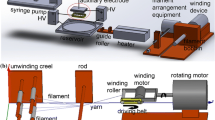Abstract
Nanofiber yarns with controlled twist levels were prepared by twisting a narrow fibrous strip cut directly from electrospun nanofiber mats. The effects of fiber morphology, diameter and orientation, as well as the yarn twist level on the yarn tensile properties were examined. For the yarns made from randomly oriented fine uniform nanofibers (e.g, diameter 359 nm) and beaded nanofibers, the tensile strength increased with increasing the yarn twist level. Higher fiber diameter (e.g, 634 nm) led to the tensile strength having an initial increase and then decrease trend. The modulus increased with the twist level for all the yarns studied. However, the elongation at break increased initially with the twist level and subsequently decreased. The orientation of aligned fibers within the fiber strip greatly influenced the yarn tensile properties. When the fibers were oriented along the fiber length direction, both tensile strength and modulus were the largest.









Similar content being viewed by others
References
D. Li and Y. Xia: Electrospinning of nanofibers: Reinventing the wheel? Adv. Mater. 16, 1151 (2004).
A. Greiner and J. Wendorff: Electrospinning: A fascinating method for the preparation of ultrathin fibers Angew. Chem. Int. Ed. 46, 5670 (2007).
J. Fang, H. Niu, T. Lin, and X. Wang: Applications of electrospun nanofibers Chin. Sci. Bull. 53, 2265 (2008).
E. Smit, U. Buttner, and R.D. Sanderson: Continuous yarns from electrospun fibers Polymer 46, 2419 (2005).
H. Pan, L. Li, L. Hu, and X. Cui: Continuous aligned polymer fibers produced by a modified electrospinning method Polymer 47, 4901 (2006).
X. Wang, K. Zhang, M. Zhu, H. Yu, Z. Zhou, Y. Chen, and B.S. Hsiao: Continuous polymer nanofiber yarns prepared by self-bundling electrospinning method Polymer 49, 2755 (2008).
P. Dalton, D. Klee, and M. Moller: Electrospinning with dual collection rings Polymer 46, 611 (2005).
A.F. Lotus, E.T. Bender, E.A. Evans, R.D. Ramsier, D.H. Reneker, and G.G. Chase: Electrical, structural, and chemical properties of semiconducting metal oxide nanofiber yarns J. Appl. Phys. 103, 024910 (2008).
U. Ali, Y. Zhou, X. Wang, and T. Lin: Direct electrospinning of highly twisted, continuous nanofiber yarns J. Text. Inst. (2010, in press).
T. Lin, H. Wang, H. Wang, and X. Wang: The charge effect of cationic surfactants on the elimination of fibre beads in the electrospinning of polystyrene Nanotechnology 15, 1375 (2004).
R. Inai, M. Kotaki, and S. Ramakrishna: Deformation behavior of electrospun poly(L-lactide-co-ε-caprolactone) nonwoven membranes under uniaxial tensile loading J. Polym. Sci, Part B: Polym. Phys. 43, 3205 (2005).
J.W.S. Hearle, P. Grosberg, and S. Backer: Structural Mechanics of Fibers, Yarns, and Fabrics, Vol. 1 (pmWiley-Interscience, New York, 1969), pp. 276–283.
P.R. Lord: Handbook of Yarn Production: Technology, Science and Economics, 1st ed. (CRC Press, Boca Raton, FL, 2003), pp.58–59.
L.M. Bellan and H.G. Craighead: Molecular orientation in individual electrospun nanofibers measured via polarized Raman spectroscopy Polymer 49, 3125 (2008).
L.H. Catalani, G. Collins, and M. Jaffe: Evidence for molecular orientation and residual charge in the electrospinning of poly(butylene terephthalate) nanofibers Macromolecules 40, 1693 (2007).
Acknowledgments
Funding support from Australian Research Council under its Discovery grant scheme and from Deakin University under the Central Research Grant scheme is acknowledged.
Author information
Authors and Affiliations
Corresponding author
Rights and permissions
About this article
Cite this article
Zhou, Y., Fang, J., Wang, X. et al. Strip twisted electrospun nanofiber yarns: Structural effects on tensile properties. Journal of Materials Research 27, 537–544 (2012). https://doi.org/10.1557/jmr.2011.295
Received:
Accepted:
Published:
Issue Date:
DOI: https://doi.org/10.1557/jmr.2011.295




